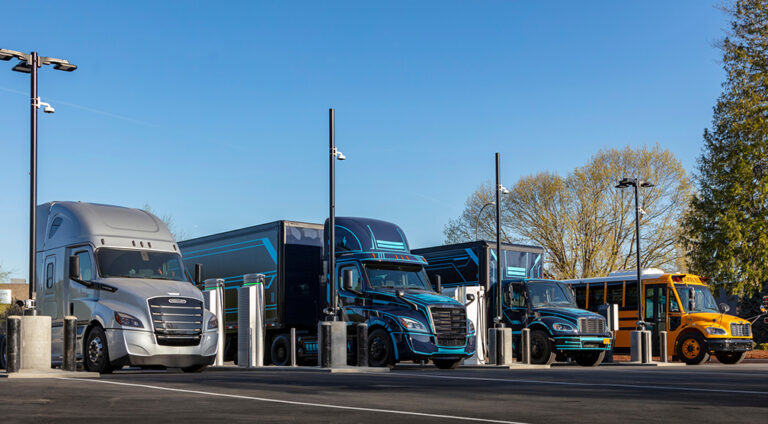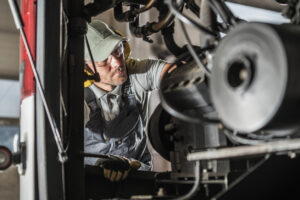Electric vehicles are the future for the trucking industry, according to experts.
The problem is, electric vehicles (EVs) are already here and they’re proving to be a cost-effective alternative to diesel, according to a study entitled, “POWER UP: Global Commercial Electric Vehicle Markets to 2040.”
The study, conducted by ACT Research, covered the commercial use of both battery electric vehicles (BEVs) and fuel cell electric vehicles (FCEVs) in more than 20 countries on four continents. Eighty-five unique medium-duty and heavy-duty applications were studied.
“What struck me is how many vehicle applications today have a better total cost of ownership than diesel,” said Ann Rundle, ACT’s vice president of electrification and autonomy.
The study showed that 72% of the EVs in use were cheaper, including initial purchase as well as maintenance costs, than equivalent diesel-powered vehicles. In the U.S., that number rises to 75%. However, those numbers don’t include typical irregular-route, long haul trucking — yet.
“A yard tractor? Buy the electric,” Rundle remarked. “A garbage truck? Buy the electric.”
Rundle has spent much of her career working to support environmental causes, but she stresses that buyers aren’t purchasing for environmental concerns.
“All things considered, you’re buying on a total cost of ownership; you’re buying on a return on investment kind of a mentality,” she explained.
Don’t be fooled by Rundle’s environmental work — this woman is an engineer. Her father often sailed on Lake Michigan and frequently took her along. Fascinated by the workings of the equipment on the sailboat, she earned an engineering degree from the University of Michigan and went to work as a naval architect. She later earned her master of business administration in operations and marketing from San Diego State University.
Today, she’s helping ACT develop forecasts that can help companies make sound vehicle investment decisions.
Undoubtedly, EVs are still tethered by the very technology that makes them work. Driving a local route and returning to the same terminal where electrics is an ideal setup. On the other hand, driving 600 miles and then finding a truck stop that has a charging station to “fuel up” electric rigs is a different story. Diesels are still necessary for those applications, for now.
The change won’t be sudden — there won’t be a day when the industry suddenly throws the switch and retires the diesel engine. It’ll happen one truck at a time. For over-the-road work, EVs are being adopted for local runs.
As batteries improve and range increases, we’ll see EVs adopted for linehauls from terminal to terminal and for regional out-and-back runs. In many cases, those types of runs keep drivers closer to home and get them to the house more often, making them more desirable positions. As the charging infrastructure grows, more runs will go electric.
As the move to make EVs viable for longer runs ramps up, one possibility is FCEVs, where electricity is provided by a fuel cell, usually powered by hydrogen. FCEVs can go incredible distances, but there are drawbacks. One of the biggest is efficiency.
“With a battery electric, about 75% of the total energy is used to power the vehicle,” Rundle explained. “With fuel cell electric, you’re down to about 29% efficiency. That’s not much better than diesel at 23-something percent.”
With batteries, some energy is lost in the charging process and there are other losses in transmitting power from the generating station. With fuel cells, it takes a great deal of energy to manufacture hydrogen, which is usually done through a process known as steam-methane reforming. Afterwards, the gas must be compressed and transported to its destination, using more energy. The end result is that more than 70% of the energy created is lost before a single electron reaches the electric motor.
Another consideration is pollution. The process of creating and transporting hydrogen generates carbon, partially negating the reason for using it in the first place. Producers are researching production of “green” hydrogen, which is made with renewable energy, but the supply is limited.
Improvements are frequent, however — and each stride brings the industry closer to electric.
“Motor and inverter technology is getting better — and as battery efficiency increases, costs come down,” Rundle remarked. “It all adds up.”
While the costs of owning and operating EVs is declining, the cost of operating diesel equipment keeps going up. It will very likely go up again when the next round of diesel emissions standards set by the U.S. Environmental Protection Agency (EPA) go into effect for the year 2027. Trucks featuring the new technology will cost more, while restrictions on new drilling and fracking will push diesel fuel prices higher.
Additionally, government mandates such as the California Air Resources Board’s (CARB) goal of all zero-emissions vehicles by the year 2045 will help drive the change, as will financial incentives for new equipment provided by various agencies. An example is the up to $30,000 income tax credit for the cost of adding charging infrastructure that ended Dec. 31, 2021.
“We’ve reached some sort of a tipping point where the technology is no longer supported by environmentally conscious people, and it’s tipped now into the territory where we’re saying it’s good for business,” Rundle explained.
How soon will electric vehicles be adopted?
“By 2030, we’ll be at a 30% to 35% adoption rate,” Rundle said. “When we get to 2040, we’re past 50%.”
The “Power Up” study predicts that BEVs will top 50% of the commercial vehicle market by 2040. For now, medium-duty and local heavy-duty applications are the early adopters, but that will change over time. As charging infrastructure is built, carriers with lanes along routes where charging is available will begin investing in EVs.
In April 2021, Daimler Trucks North America and Portland General Electric teamed up to open the first public heavy-duty truck charging station dubbed “Electric Island.” The Bipartisan Infrastructure Law announced by the White House Dec. 13, 2021, provides $5 billion in formula funding to be used for charging infrastructure.
What it all boils down to is this: The reality is that if you began a career in trucking in the past few years, there’s a very good chance you’ll be driving an electric-powered truck before your career ends.
Cliff Abbott is an experienced commercial vehicle driver and owner-operator who still holds a CDL in his home state of Alabama. In nearly 40 years in trucking, he’s been an instructor and trainer and has managed safety and recruiting operations for several carriers. Having never lost his love of the road, Cliff has written a book and hundreds of songs and has been writing for The Trucker for more than a decade.















Fuck That Shit. Give me Diesel or I will just retire. You shove the Automatic slow ass Trucks up your ass also
I call BS. If we ever reach the point where electric trucks are the only alternative, at that time we will truly regret tearing up so many rail lines and turning them into rail trails.